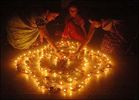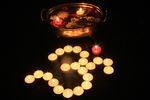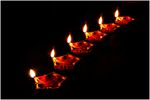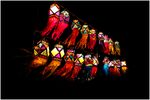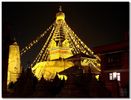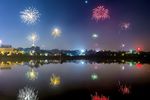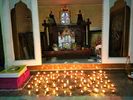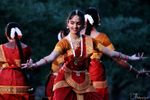ديوالي
| Deepawali | |
|---|---|
 Rangoli decorations, made using coloured fine powder or sand, are popular during Diwali. | |
| يُسمى أيضاً | Deepavali |
| يُحتفى به | Hindus, Jains, Sikhs, some Buddhists (notably Newar Buddhists).[1] |
| النوع | Cultural, seasonal, religious |
| الاحتفالات | Diya and lighting, home decoration, shopping, fireworks, puja (worship ceremonies), gifts, performing religious rituals, feast and sweets |
| التاريخ | Amavasya of Kartik month (Date varies per Hindu calendar) |
| الارتباط | Diwali (Jainism), Bandi Chhor Divas, Tihar, Swanti, Sohrai, Bandna |
ديوالي أو ديڤالي (Diwali أو Diavli [note 1] ؛ (Dipavali in Sanskrit, meaning "row of lamps"; also spelled Divali or Deepavali) هو عيد هندوسي يحتفل به في فصل الخريف. ومعناه عيد الأنوار.[7][8] One of the most popular festivals of Hinduism, Diwali symbolises the spiritual "victory of light over darkness, good over evil and knowledge over ignorance."[9][10][11] During the celebration, temples, homes, shops and office buildings are brightly illuminated.[12] The preparations, and rituals, for the festival typically last five days, with the climax occurring on the third day coinciding with the darkest night of the Hindu lunisolar month Kartika. In the Gregorian calendar, the festival generally falls between mid-October and mid-November.[13]
In the lead-up to Diwali, celebrants will prepare by cleaning, renovating, and decorating their homes and workplaces.[14] During the climax, revellers adorn themselves in their finest clothes, illuminate the interior and exterior of their homes with diyas (oil lamps or candles), offer puja (worship) to Lakshmi, the goddess of prosperity and wealth,[note 2] light fireworks, and partake in family feasts, where mithai (sweets) and gifts are shared. Diwali is also a major cultural event for the Hindu and Jain diaspora from the Indian subcontinent.[17][18][19]
The five-day festival originated in the Indian subcontinent and is mentioned in early Sanskrit texts. The names of the festive days of Diwali, as well as the rituals, vary by region. Diwali is usually celebrated eighteen days after the Dussehra (Dasara, Dasain) festival with Dhanteras, or the regional equivalent, marking the first day of the festival when celebrants prepare by cleaning their homes and making decorations on the floor, such as rangoli.[20] The second day is Choti Diwali, or equivalent in north India, while for Hindus in the south of India it is Diwali proper. Western, central, eastern and northern Indian communities observe Diwali on the third day and the darkest night of the traditional month. In some parts of India, the day after Diwali is marked with the Govardhan Puja and Diwali Padva, which is dedicated to the relationship between wife and husband. Some Hindu communities mark the last day as Bhai Dooj, which is dedicated to the bond between sister and brother,[21] while other Hindu and Sikh craftsmen communities mark this day as Vishwakarma Puja and observe it by performing maintenance in their work spaces and offering prayers.[22][23]
Some other faiths in India also celebrate their respective festivals alongside Diwali. The Jains observe their own Diwali, which marks the final liberation of Mahavira,[24][25] the Sikhs celebrate Bandi Chhor Divas to mark the release of Guru Hargobind from a Mughal Empire prison,[26] while Newar Buddhists, unlike other Buddhists, celebrate Diwali by worshiping Lakshmi.[27][28] The festival of Diwali is an official holiday in Fiji,[29] Guyana,[30] India, Malaysia (except Sarawak),[31] Mauritius, Myanmar,[32] Nepal,[33] Singapore,[34] Sri Lanka, Suriname, and Trinidad and Tobago.[35]
الاسم والتواريخ
| |||||||||
يقام ديوالي احياءً لذكرى لاكشمي، إلهة الثروة. ويستمر المهرجان لمدة 5 ايام يكون اليوم الرابع فيها ملئ بالألعاب النارية احتفالاً براس السنة . وتضاء الشموع في البيوت خلال الديوالي.
المراسيم
تكون مراسيم الحفل عبارة عن حمل الكثير من الشعل النارية على الجدران وعند المداخل، ويعد الاحتفال هو وقت زيارة الاقارب والاصدقاء واهداء الهدايا، زخرفة البيوت.
أصل الكلمة
Deewali كلمة سنسكريتية الاصل
وتعني صف من الاضواء
وهو يعرف بمهرجان الضوء
ويرمز إلى انتصار الخير على الشر
وانتصار النور على الظلمة
فالنور يرمز للامل والنصر
ويعتبر ديفالي أحد المهرجانات الأكثر شعبية والمنتظرة بلهفة في الهند عند الصغار والكبار. يستمر ل5 أيام متتالية في الشهر الهندوسي لأشوايجا الذي يقابل شهر أكتوبر/تشرين الأول عادة أو نوفمبر/تشرين الثّاني.
و يحتفل بديوالي الهندوس والسيخ ويعتبر مناسبة للاحتفال بالحياة وتقوية العلاقات الاجتماعية الأيــام الخمسة لديفالي اليـوم الأول = Dhanteras
يدعى اليوم الأول ب Dhanvantari Triodasi أو Dhan Theras. هو يقابل 13 القمرية لKrishna Paksh، ال 14 المظلمة من شهر Kartik. في هذا اليوم، Lord Dhanwantari خرج من المحيط البشري. وهذا يكون اليوم الأول من احتفالات ديوالي. في هذا اليوم عن الغروب. الهندوس يستحمون ويشعلون deeya مع Prasad. لورد الموت يصلي ليحمي untimely الموت. وهذا يكون قرب شجرة Tulsi، شجرة الريحان المقدسة أو اي شجرة أخرى يمكن ان تجدها في فنائهم.
اليوم الـثانـي Choti Diwali
اليوم الثاني من ديوالي يسمى Narak Chaturdasi. في هذا اليوم اللورد Krishna دمر الشيطانة Narakasur وحرر العالم من الخوف. في هذا اليوم. يتم دلك الجسم بالزيت ليخفف من التعب. بعد الحمام والاستراحة يمكن اكمال ديوالي في نشاط وتفاني. في هذه الليلة Yama Deeya يجب أن لا يشعل.
اليوم الثـالث Lakshmi Puja on Diwali
في هذا اليوم يتم التعبد للأم Lakshmi. الهندوس يطهرون انفسهم ويلتقون مع اسرتهم و Pandit يقومون بالتعبد للإلاهة Lakshmi حتى تبارك العالم وتمنحهم البركة والازدهار والثروة. Mosab alza7f
وانتصار الخير على الشر والضوء على الظلام
اليوم الرابع Padwa & Govardhan Puja
في هذا اليوم. انجزت Govardhan Pooja قبل آلاف السنين، اللورد Krishna افرج عن الناس من سيطرت Vraja لأجل Govardhan Pooja. منذ ذلك الوقت وكل سنة في هذا اليوم الهندوس يعبدون Govardhan Pooja لاعتبارها السبب في الافراج عن الناس من قبضة Vraja.
اليــوم الخامس والاخير Bhai Duj
اليوم الخامس من ديوالي يسمى Bhratri Dooj. هذا اليوم عقب انجاز Goverdhan Pooja وهو في العادة يومان بعد ديوالي ،هو يوم مخصص للأخوات. قبل أقمار (سنين قمرية) عديدة وفي ذلك العصر Yama = Yamraj لورد الموت زار اخته Yamuna في هذا اليوم. اعطى اخته Vardhan (a boon) على انه عندما سيزورها في هذا اليوم سيكون محرر من كل الخطايا وسيحققون Moksha أو عملية تحرير نهائية. في هذا اليوم الاخوان يزورون اخواتهم ويستخبرون من خيرهم. هذا اليوم يكن اخر ايام الاحتفال بديوالي. وعرف أيضا ب Bhai fota عند البنغاليين حيت تقوم الاخت بالصلاة لاجل اخيها حتى يعيش في امان.
مرئيات
| هنود يبحثون عن الحظ السعيد يستلقون أرضا كي تدوسهم الأبقار في عيد ديوالي في الهند. |
معرض الصور
- Dipavali Fire Crackers.jpg
Dipavali Fire Crackers
انظر أيضاً
- Galungan – the Balinese Hindu festival of dharma's victory over adharma
- Hanukkah – the Jewish festival of lights
- Lantern Festival – the Chinese festival of lanterns
- Saint Lucy's Day – the Christian festival of lights
- Walpurgis Night – the German festival of bonfires
ملاحظات
- ^ The name of the festival in various regional languages include:
Sanskrit: दीपावली, Dīpāvalī ?, Tamil: தீபாவளி, Tīpāvaḷi ?, Nepali: दीपावली, तिहार, Dīpāvalī, Tihāra ?, هندوسية: दिवाली, Divālī ?, Gujarati: દિવાળી, Divāḷī ?, Marathi: दिवाळी, Divāḷī ?, Kannada: ದೀಪಾವಳಿ, Dīpāvaḷi ?, Konkani: धाकली दिवाळी, Dhākalī Divāḷī ?, Malayalam: ദീപാവലി, Dīpāvali ?, Oriya: ଦୀପାବଳୀ, Dīpābaḷī ?, Punjabi: ਦਿਵਾਲੀ, Divālī ?, Telugu: దీపావళి, Dīpāvaḷi ?, Urdu: دیوالی, Dy̰wạly̰ ? - ^ Hindus of eastern and northeastern states of India associate the festival with the goddess Durga, or her fierce avatar Kali (Shaktism).[15] According to McDermott, this region too celebrated Lakshmi puja historically, and the Kali puja tradition started in the colonial era, particularly after the 1920s.[16]
الهامش
- ^ Townsend, Charles M (2014). TheOxford Handbook of Sikh Studies. Oxford University Press. p. 440. ISBN 978-0-19-969930-8.
- ^ 2020 Hindu Festivals Calendar, Hindu Tyohar Calendar for Glen Gardner, New Jersey, United States
- ^ https://www.drikpanchang.com/calendars/hindu/hinducalendar.html
- ^ https://www.drikpanchang.com/diwali/hanuman-puja/hanuman-puja-date-time.html?year=2020
- ^ https://www.drikpanchang.com/festivals/abhyangsnan/festivals-abhyangsnan-timings.html?year=2020
- ^ https://www.drikpanchang.com/festivals/gujarati-newyear/gujarati-newyear-date-time.html?year=2020
- ^ The New Oxford Dictionary of English (1998) ISBN 0-19-861263-X. p. 540 "Diwali /dɪwɑːli/ (also Divali) noun a Hindu festival with lights...".
- ^ Diwali Encyclopædia Britannica (2009)
- ^ Vasudha Narayanan; Deborah Heiligman (2008). Celebrate Diwali. National Geographic Society. p. 31. ISBN 978-1-4263-0291-6., Quote: "All the stories associated with Deepavali, however, speak of the joy connected with the victory of light over darkness, knowledge over ignorance, and good over evil".
- ^ خطأ استشهاد: وسم
<ref>غير صحيح؛ لا نص تم توفيره للمراجع المسماةhtoday - ^ Jean Mead, How and why Do Hindus Celebrate Divali?, ISBN 978-0-237-534-127
- ^ أ ب Frank Salamone (2004), Encyclopedia of Religious Rites, Rituals and Festivals, ISBN 978-0415880916, Routledge, pp. 112–13, 174, 252
- ^ خطأ استشهاد: وسم
<ref>غير صحيح؛ لا نص تم توفيره للمراجع المسماةmelton252 - ^ Pramodkumar (March 2008). Meri Khoj Ek Bharat Ki. ISBN 978-1-4357-1240-9. Retrieved 26 October 2011.
It is extremely important to keep the house spotlessly clean and pure on Diwali. The Goddess Lakshmi likes cleanliness, and she will visit the cleanest house first. Lamps are lit in the evening to welcome the goddess. They are believed to light up her path.
- ^ Laura Amazzone 2012.
- ^ McDermott 2011, pp. 183–88.
- ^ India Journal: ‘Tis the Season to be Shopping Devita Saraf, The Wall Street Journal (August 2010)
- ^ Henry Johnson 2007, pp. 71–73.
- ^ Kelly 1988, pp. 40–55.
- ^ Karen Bellenir (1997), Religious Holidays and Calendars: An Encyclopedic Handbook, 2nd Edition, ISBN 978-0780802582, Omnigraphics
- ^ Rajat Gupta; Nishant Singh; Ishita Kirar. Hospitality & Tourism Management. Vikas. p. 84. ISBN 978-93-259-8244-4.
- ^ Kristen Haar; Sewa Singh Kalsi (2009). Sikhism. Infobase Publishing. pp. 98–99. ISBN 978-1-4381-0647-2.
- ^ Shobhna Gupta (2002). Festivals of India. Har-Anand. p. 84. ISBN 978-81-241-0869-7.
- ^ Sharma, S.P.; Gupta, Seema (2006). Fairs and Festivals of India. Pustak Mahal. p. 79. ISBN 978-81-223-0951-5.
- ^ Upadhye, A.N. (Jan–Mar 1982). Cohen, Richard J. (ed.). "Mahavira and His Teachings". Journal of the American Oriental Society. 102 (1): 231–32. doi:10.2307/601199. JSTOR 601199.
- ^ Geoff Teece (2005). Sikhism. p. 23. ISBN 978-1-58340-469-0.
- ^ خطأ استشهاد: وسم
<ref>غير صحيح؛ لا نص تم توفيره للمراجع المسماةdiwaliBuddhist - ^ Prem Saran (2012). Yoga, Bhoga and Ardhanariswara: Individuality, Wellbeing and Gender in Tantra. Routledge. p. 175. ISBN 978-1-136-51648-1.
- ^ Public Holidays, Government of Fiji
- ^ Public Holidays, Guyana
- ^ Public Holidays, Government of Malaysia
- ^ Public Holidays, Government of Myanmar
- ^ Public Holidays, Government of Nepal
- ^ Public Gazetted Holidays, Government of Singapore
- ^ Official Public Holidays, Government of Trinidad & Tobago
- ^ خطأ استشهاد: وسم
<ref>غير صحيح؛ لا نص تم توفيره للمراجع المسماةtp - ^ Deborah Heiligman, Celebrate Diwali, ISBN 978-0-7922-5923-7, National Geographic Society, Washington, D.C.
وصلات خارجية
- ديوالي at the Open Directory Project
- The Hindu Festival of Divali in the Caribbean, J.C. Jha (2017), A Journal of Caribbean Culture, Taylor & Francis
- The Ancient Origins of Diwali, India’s Biggest Holiday, Becky Little (2017)
- Diwali Downunder: Transforming and Performing Indian Tradition in Aotearoa/New Zealand, H Johnson and G Figgins (2014)
- From Holi to Diwali in Fiji: An Essay on Ritual and History, John D Kelly (1988)
- Short description is different from Wikidata
- Infobox holiday with missing field
- Infobox holiday (other)
- Articles using infobox templates with no data rows
- ديوالي
- Autumn festivals
- Festivals in India
- Festivals in Nepal
- Fireworks events in Asia
- Harvest festivals in India
- Hindu festivals
- Jain festivals
- Non-Gregorian November observances
- Non-Gregorian October observances
- Observances set by the Indian National Calendar
- Public holidays in India
- Public holidays in Nepal
- Public holidays in Sri Lanka
- Religious festivals in India
- Sikh festivals
- Traditions involving fire
- Autumn holidays (Northern Hemisphere)
- Spring holidays (Southern Hemisphere)
